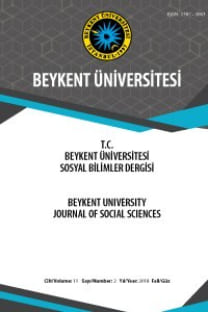Impact of Shocks on the Development of Turkish Banking Industry
Özet: Shock concepts have been studied in the literature to identify their impact on the development of various industries. Banking industry particularly in a developing country context seeks more attention as there has certainly been a close association throughout most of their shared history. This paper, therefore, aims to illuminate the impact of industry specific, country specific and international shocks on the development of Turkish banking industry since its existence from the period of Ottoman Empire until today's modern Turkey (1299-2013).
Anahtar Kelimeler:
political instability, banking industry; shock concepts; Turkey; Ottoman Empire
Özet: Shock concepts have been studied in the literature to identify their impact on the development of various industries. Banking industry particularly in a developing country context seeks more attention as there has certainly been a close association throughout most of their shared history. This paper, therefore, aims to illuminate the impact of industry specific, country specific and international shocks on the development of Turkish banking industry since its existence from the period of Ottoman Empire until today's modern Turkey (1299-2013).
___
- Akguc, O. (1987). Türkiyede Bankacılık. Gerçek Yayınevi, Istanbul.
- Akkurt, A., D. Hakioglu, A. Karayalcin, O.C. Koc, A. Senel, N. Usta, and O. Varol. (1992). Developments in the Turkish Banking Sector: 1980-1990. in Aydogan, K. and Ersel, H., (eds). Issues in Banking Structure and Competition in a Changing World, conference proceedings, Central Bank of Republic of Turkey, Ankara.
- Akyuz, Y. (1980). Sermaye Bölüşüm Büyüme, Ankara: A. Ü. Siyasi Bilimler Fakültesi Yayınları, 453.
- Alper, C.E., and Z. Onis. (2001). Financial Globalization, the Democratic Deficit and Recurrent Crises in Emerging
- Markets: The Turkish Experience in the Aftermath of Capital Account Liberalization. Bogazici University Department of Economics Working Papers, ISS/EC 01-14. Altunbas, Y., A. Kara, and O. Olgu. (2009). Turkish Banking: Banking under Political Instability and Chronic High
- Inflation, Palgrave Macmillan. Banks Association of Turkey. Banks in Turkey Report 19 (1999b): available at http://www.tbb.org.tr/english/v12/1999.asp. Banks Association of Turkey. Banks in Turkey Report 200 (2009): available at http://www.tbb.org.tr/english/v12/2009.asp.
- Banks Association of Turkey. In its 40th year the Banks Association of Turkey and Turkish Banking System. Turkish Bankers Association Publications, (1999a): available at http://www.tbb.org.tr/english/40.htm.
- Burt, S. (2010). Retailing in Europe: 20 Years on. The International Review of Retail, Distribution and Consumer Research, 20, 1, 9–27.
- Collier, P., and A. Hoeffler. (2004). Greed and Grievance in Civil War. Oxford Economic Papers, 56, 4, 563-595.
- De Bonis, R., A. Giustiniani, and G. Gomel. (1999). Crises and Bail-outs of Banks and Countries: Linkages,
- Analogies and Differences. World Economy, 22, 1, 55-86. Denizer, C. (1997). The Effects of Financial Liberalization and New Bank Entry on Market Structure and Competition in Turkey. The World Bank Policy Research Working Paper Series, 1839.
- Elbadawi, I., and H. Hegre. (2008). Globalization, Economic Shocks and International Armed Conflict. Defense and Peace Economics, 19, 1, 37-60.
- Miskin, F.S. (2006). The Next Great Globalization, Princeton University Press.
- Ozkan, F.G. (2003). Currency and Financial Crises in Turkey, 2000–2001: Bad Fundamentals or Bad Luck?.
- University of York, and CEPR, 12. Pehlivan, H. (1996). Financial Liberalization and Bank Lending Behaviour in Turkey. Savings and Development, 20, 2, 171-187.
- Quek, M. (2011). Comparative Historical Analysis of Four UK Hotel Companies: 1979 – 2004. Journal of
- International Contemporary Hospitality Management, 23, 2, 147-173. Ozlem Olgu / Beykent University Journal of Social Sciences Vol 6, No 2, 2013. ISSN: 1307-5063 20
- ISSN: 1307-5063
- Yayın Aralığı: Yılda 2 Sayı
- Başlangıç: 2007
- Yayıncı: Beykent Üniversitesi
Sayıdaki Diğer Makaleler
Impact of Shocks on the Development of Turkish Banking Industry
K. M. Anwarul ISLAM, M. Muzahidul ISLAM, Mahbuba ZAMAN
Quality Improvement in Manufacturing Processes to Defective Products using Pareto Analysis and FMEA
Analysis of Corporate Income Tax Rate Changes and Earnings Management
Martin Surya MULYADİ, Yunita ANWAR, Lili YANNY
Enigma of Silence in Organizations: What Happens To Whom and Why?
Empirical Analysis of Weak Form Efficiency Evidence from National Stock Exchange of India Ltd
S. AYYAPPAN, S. Nagarajan, M. SAKTHİVADİVEL, K. PRABHAKARAN
